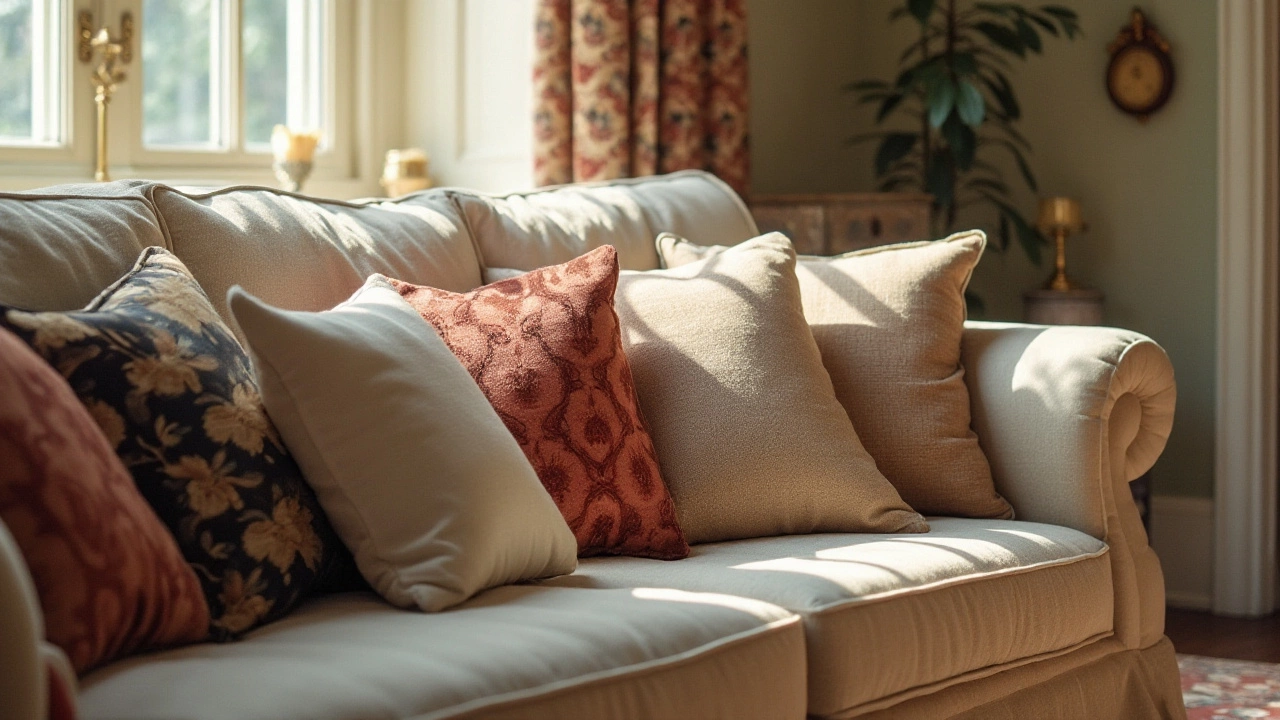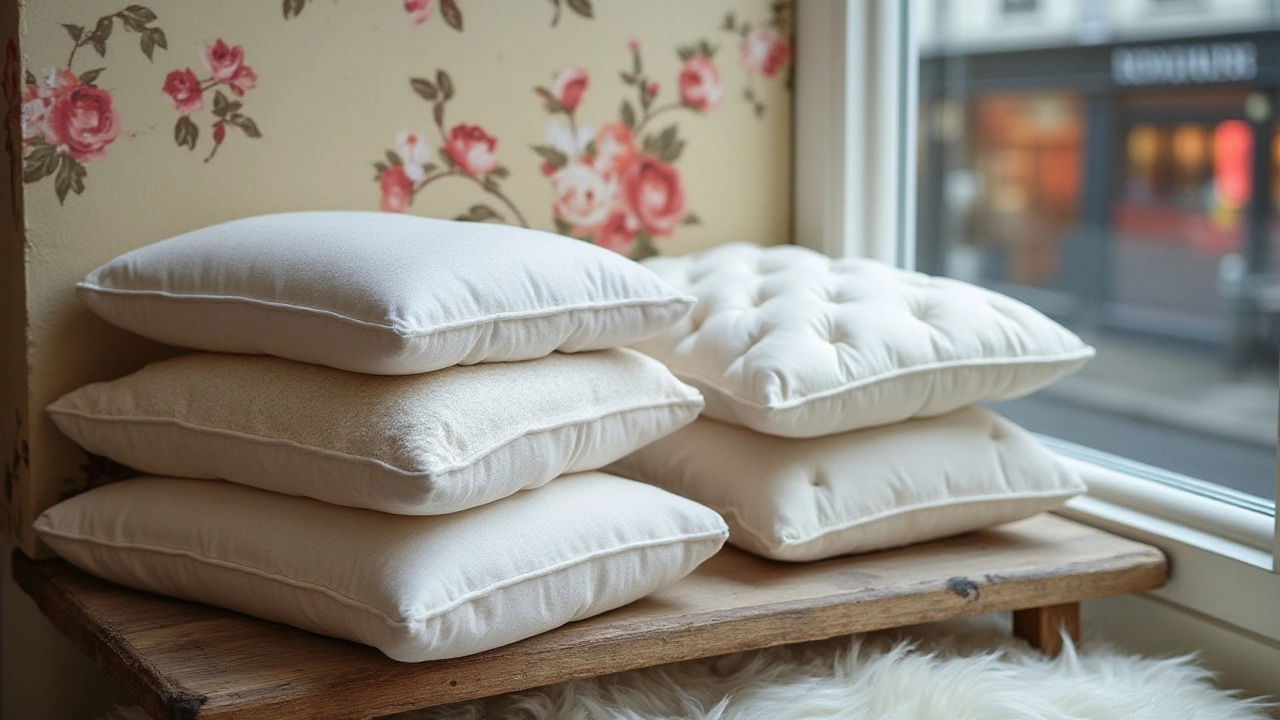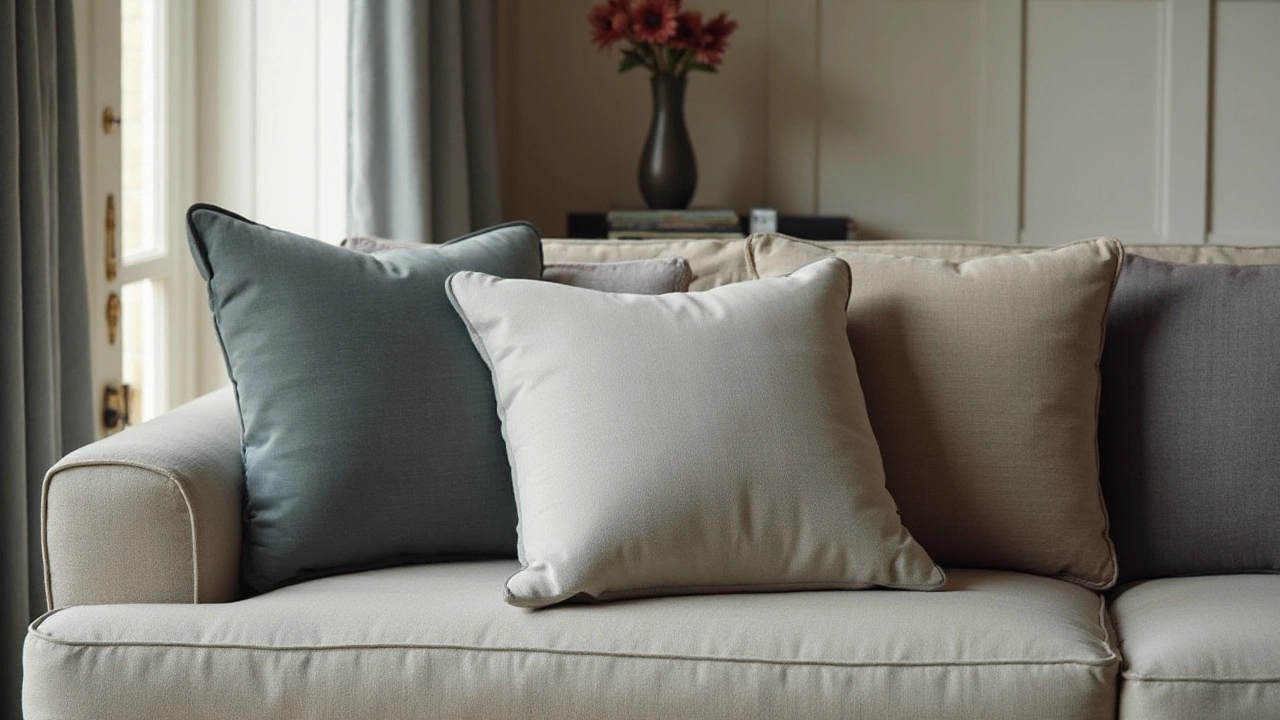Durable Cushions That Maintain Their Shape All Year Round
 Dec, 25 2024
Dec, 25 2024
When it comes to enhancing the comfort of your home, cushions play an integral part. They're not just decorative additions but also pivotal in contributing to a welcoming atmosphere. The concern for many, however, is how swiftly some cushions lose their shape, transforming from plump companions to lackluster flatties.
In this guide, we delve into the anatomy of resilient cushions. We aim to provide insights on materials and designs that promise longevity, ensuring they remain as supportive and attractive as the day you brought them home. Whether it’s the choice of filling or fabric, every element plays a role in the durability of your cushions.
- Understanding Cushion Fillings
- High-Performance Foam Cushions
- Memory Foam Versus Polyester
- The Role of Fabrics in Shape Retention
- Maintenance Tips for Lasting Cushions
- Choosing the Right Cushion for Your Home
Understanding Cushion Fillings
Delving into the world of cushions, understanding cushion fillings is paramount if you want your cushions to retain both shape and comfort over time. The filling is essentially the heart of a cushion, defining its feel, longevity, and suitability for specific needs. One popular filling choice is foam, celebrated for its robust support and versatility. Foam fillings can range from simple cut pieces to highly engineered varieties designed for specific support or aesthetical requirements, which can profoundly impact a cushion's performance. Many find high-density foam cushions preferable for their remarkable ability to fend off flattening, often serving well as seating cushions in frequently used environments.
Another noteworthy option within the realm of cushion fillings is polyester fiberfill, or polyfill, which is commonly used in soft furnishings. It is known for its exquisite softness and is often embraced by those who value plush cushioning experiences. Yet, the downside to polyester is its tendency to compress and lose its fluff over time, resulting in a more worn-out appearance rather quickly. That's why blends using resilient additives are becoming increasingly sought after. Memory foam, renowned for its contouring properties, has seen widespread adaptation in cushions as well. Unlike standard foam, memory foam offers a more contoured seating experience, making it a great choice for those needing customized support.
A classic choice often found in luxurious settings is down or feather fillings, prized for their unbeatable plushness and warmth. Yet, they require consistent fluffing to maintain their shape and are best paired with high-thread-count covers to keep feathers contained. "Feather and down filled cushions represent luxury and provide unmatched comfort," notes interior designer Lydia Blanco.
Lydia adds, "However, they demand a bit more care and attention to retain their appeal."These natural fillings do possess a knack for wear, but when combined with resilient cores, they strike a perfect balance between comfort and endurance.
If you’re aiming for durable cushions, consider examining the latest advancements like latex, which is lauded for its natural resilience and hypoallergenic properties. Latex-filled cushions can offer a pleasant balance between firm support and gentle give, making them an ideal option for a wide range of uses. Unlike other fillings, latex is derived from rubber trees, and its natural composition makes it far more durable compared to traditional synthetic foams. Perhaps the most intriguing alternative in modern times is the combination of different materials into hybrid cushions. By expertly blending polyfill with foam or down surrounds with dense cores, manufacturers can now provide cushions that feature the best of multiple worlds. Such innovation supports a cushion’s longevity while simultaneously prioritizing user comfort.
Let’s take a moment to admire some statistics surrounding cushion longevity based on filling types. Consider a study showcasing cushion lifespan, where high-density foam and hybrid fillings came in top with an average lifespan exceeding five years of use in high-traffic areas, surpassing feather or polyester by a notable margin.
High-Performance Foam Cushions
The world of cushions has been significantly transformed by advances in foam technology. High-performance foam stands out as a leading choice for those seeking durability and resilience in their home comfort essentials. Unlike conventional stuffing, these foams are engineered to maintain their structure over extended periods, resisting the flattening and lumpiness that is all too common with other fillings. One of the key benefits of high-performance foam cushions is their ability to provide consistent support, making them ideal for a range of furniture from sofas to patio seating.
What sets high-performance foam apart is its density and structural integrity. Denser foams inherently have a higher support factor, meaning they can withstand more weight and pressure without sagging. This aspect is particularly beneficial in busy households where furniture sees a lot of use. Foam density is often measured in pounds per cubic foot, and a high-quality cushion typically ranges from 1.8 to 2.5 pounds. Such density doesn't just promise longevity; it also ensures that cushions remain firm and comfortable. According to experts, choosing the right foam density can make all the difference. Professional upholsterer Jonathan Anderson once noted, "A well-crafted foam cushion blends comfort and toughness, making furniture inviting yet enduring."
Within the realm of high-performance foam, memory foam deserves a special mention. Originally developed by NASA, memory foam adapts to the body's contours, offering personalized support and supreme comfort. Its viscoelastic properties allow it to return to its original shape after each use, addressing the common issue of deformation in cushions. This benefit is complemented by its ability to reduce pressure points, promoting better posture and relaxation. However, it's worth noting that while memory foam boasts adaptability, it may trap heat, which could be a consideration depending on climate or personal preferences.
The versatility of foam doesn't stop at memory foam. There are also open-cell and closed-cell foams, each serving different purposes. Open-cell foams are known for their breathability, allowing air and moisture to pass through, which keeps the cushions cooler and more comfortable, especially during warmer months. Closed-cell foams, by contrast, offer superior water resistance, making them ideal for outdoor furniture that is exposed to the elements. Regardless of the foam type, proper maintenance can significantly extend the life of your cushions. Regular rotation and flipping of the cushions, along with cleaning, can help maintain their integrity and appearance.
For those eager to invest in long-lasting comfort, considering the appropriate cover for high-performance foam cushions is equally important. A fabric that stretches and moves with the foam will reduce stress on seams and enhance longevity. Additionally, covers made from natural fibers or those with moisture-wicking properties can add to the cushion's comfort. Finally, combining these insights with a careful selection of foam characteristics and upholstery can transform any living space into a haven of relaxation, where cushions always keep their inviting shape.

Memory Foam Versus Polyester
When it comes to selecting cushions that are both comfortable and durable, memory foam has frequently been highlighted for its ability to align and contour according to weight and pressure. Its viscoelastic nature means it can adapt to body shapes returning to its original state when not in use. This feature is particularly advantageous in creating cushions that maintain their structure and support over time. Many furniture enthusiasts posit that the dense makeup of memory foam contributes significantly to a cushion's ability to uphold its form, ensuring a reliable support that doesn’t diminish easily. The material was originally developed by NASA to improve seating comfort and crash protection for airline pilots and passengers which speaks to its resilience and design ethos. The value extends beyond mere comfort to encompass a scientific foundation aimed at human-centered design.
On the other hand, polyester is another popular choice for cushion fillings, frequently chosen for its affordability and softness. Polyester is lighter and often provides a budget-friendly alternative while still offering a satisfactory level of comfort. However, it doesn’t often match up to memory foam in terms of density and longevity. While polyester-filled cushions might initially provide a great deal of comfort, they regularly compress with frequent use, losing shape and firmness over time. This can particularly be seen in settings where cushions endure frequent daily use such as living room sofas or patio furniture.
The renowned home designer Emily Henderson once noted, “Choosing the right cushion filling is critical, as it’s not just about immediate comfort but lasting support.” Her words highlight a common dilemma for homeowners seeking balancing cost efficiency with long-term durability.
Crafting your home with durable cushions requires an understanding of material pros and cons. While the initial cost for memory foam may be higher than polyester alternatives, the return on investment is visible through the cushion's lifespan. An effective approach when furnishing your home is to conduct personal tests, feeling materials in person can sometimes tilt choices strongly. Evaluate whether the memory foam’s ability to retain shape justifies the added expense against a polyester filled cushion, which might need replacing quicker. Making an informed decision not only boosts comfort in the present moment but ensures ongoing coziness without frequent replacements. With retailers offering blends of both materials, seeking out a compromise, potentially enhanced features like gel-infused memory foams may offer tempered solutions accommodating preferences between plush softness and supportive firmness.
The Role of Fabrics in Shape Retention
The outer fabric of a cushion is more than just a pretty face; it significantly contributes to how long your cushions stay plump and comfortable. Fabrics vary widely, not only in their aesthetic appeal but in terms of durability and their ability to maintain a structured form. One misleading notion that tends to circulate is the 'softer is better' hypothesis. While soft materials can be inviting, they rarely hold up under regular use. Considerations such as fabric weave, thickness, and elasticity should be factors in the decision-making process, not just texture.
Natural fabric options like cotton and linen are often lauded for their breathability and ease of cleaning. However, these may not be the best for maintaining shape, especially in frequently used living spaces. Stronger synthetic fibers, like polyester blends or acrylic, frequently outperform in terms of stretch resilience and fade resistance. These materials are engineered for long-term use, providing not just quality feel but consistent firmness even after years of lounging and weight pressure. As noted by upholstery expert Sarah Richardson, 'The lining or backing of materials remarkably affects cushion longevity, as it supports the fabric's structure from the inside.'
- Sarah Richardson, Upholstery Expert
Additionally, factors such as frequent exposure to sunlight and moisture can accelerate wear and tear on fabric, causing cushions to lose their distinctive form faster. Fabrics with UV protection coating and mildew-resistant properties can extend the life of your outdoor cushions significantly. Consider placement when choosing a cushion material; indoor fabrics differ vastly from those suitable for outdoor use. Also, blends incorporating elastane or spandex offer stretch and flexibility, allowing cushions to bounce back easily after being compressed. There’s a growing trend of covering high-usage cushions with removable covers, made of robust fabrics that can be rotated, thus evenly distributing wear over time.
Choosing the right cover entails knowing your environment and usage needs. Machine-washable options, for instance, not only provide ease of maintenance but also ensure robust wash cycles don’t compromise fabric integrity or shrinkability. In many families, multi-functionality in daily home items is necessary. Parents often seek fabric that withstands not just time, but also spills and the playful jumps of children. Success stories often cite performance fabrics, engineered to repel stains and resist abrasion over years of family game nights and casual lounging. These aren’t just glorified textiles; they’re designed for modern, bustling lives.
In conclusion, the key to finding the perfect balance of durable and aesthetically pleasing cushion covers lies in understanding your priorities and environment. Always keep in mind that no single fabric fits every situation. Through informed choices, based on living patterns and environmental conditions, you can find cushions that maintain their shape and beauty throughout the seasons. This investment doesn’t merely enhance your home décor; it promises lasting comfort and support.

Maintenance Tips for Lasting Cushions
Maintaining the shape and longevity of your cushions is as much about care as it is about the initial quality. Regular maintenance can transform a fading piece into a fixture of comfort and style. One critical part of this care involves fluffing your cushions regularly. Frequent use leads to compression, causing filling materials such as foam or polyester to lose their bounce. By gently fluffing cushions every few weeks, you redistribute the filling, restoring their original form. Professionals often suggest a light hand wash of the covers, allowing the fabric to refresh without the risk of shrinkage that comes with machine washing. A gentle cycle in the washing machine can be used, but be cautious with high heat which can damage both the fabric and filling.
An underrated tip includes routinely rotating your cushions. Much like furniture or a mattress, varying the exposure to wear ensures that no single area bears the brunt of usage. This is particularly important for cushions placed outdoors or in direct sunlight where ultraviolet rays can weaken fabric integrity and fade colors. In winters, where indoor heating can sap moisture from fabrics, placing a humidifier in the room helps maintain cushion suppleness. Vacuuming cushions is surprisingly effective as dust and small debris often settle in the crevices of the cushion. Use the brush attachment to gently remove this collection from fabrics, ensuring that you keep allergens and potential mold growth at bay.
Protection and Placement
Beyond the basic cleaning, consider positioning your cushions wisely. Cushions exposed to direct sunlight or rain without protection degrade faster. If your cushions are part of outdoor furniture, using covers at night or during adverse weather is beneficial. Interior care is equally vital: think about using throws or covers during events or when kids are around to add an extra layer of protection without sacrificing style. When not in use, store cushions in an area with adequate ventilation to avoid moisture buildup, which could lead to mold and odor.
For those enthusiastic about DIY, consider crafting a simple storage bench for spare cushions. This not only provides a practical solution but adds an element of decor. Line the storage space with breathable fabric to ensure your cushions remain fresh. To identify the best methods for care, checking manufacturer instructions is a must, as some materials can react uniquely to cleaning solutions. As famed furniture restorer Tom Silva once mentioned,
"It's not just about keeping them clean, it's about maintaining their strength and resilience month after month."By incorporating these maintenance tips, you ensure your cushions remain comfortable and inviting, embodying both practicality and aesthetic charm in your home.
Choosing the Right Cushion for Your Home
When it comes to picking out the ideal cushions for your living space, it’s more than just a matter of color and design. The functionality and durability of the cushion should be at the forefront of your decision-making process. Selecting cushions that keep their shape is crucial not just for aesthetic reasons but also for comfort and the longevity of your furniture. So, where do you start? Understand your needs first. Consider who will be using the cushions—families with young children, for instance, often require more durable options that can withstand a bit of roughhousing. Conversely, in a more adult-centered environment, aesthetics might take precedence.
The material of the cushion is a fundamental aspect. The market offers a variety of fillings, including foam, memory foam, polyester, and down. Each of these has unique properties that affect how well a cushion retains its shape over time. For example, high-performance foam cushions are known for maintaining their shape longer due to their high resiliency. Memory foam is celebrated for its ability to conform to the shape of your body, providing superior comfort, although it can sometimes trap heat.
According to a home décor expert from Architectural Digest, "The key to long-lasting cushions that maintain form is investing in quality fillings and breathable yet durable fabrics."
In conjunction with the filling, pay attention to the outer fabric that covers your cushion. Durable fabrics like linen or canvas are beneficial, as they are less likely to wear out quickly and can better hold the shape of the cushion. Removable covers are a smart option as they can be washed or replaced, prolonging the lifespan of the cushion itself.
Matching Cushions with Your Decor
Your home’s style can greatly influence your cushion choices. Contemporary spaces might benefit from sleek, polished designs, while a more rustic setting could see advantages from casual, cozy textiles. The aim is to blend comfort with style, ensuring the cushions not only serve their functional purpose but also enhance the aesthetic appeal of your space. Consider the patterns and textures you've already implemented in your living area. Cushions can either complement or contrast these elements depending on the visual interest you're aiming to achieve.
Don’t forget, size matters. Overly large cushions can overcrowd a sofa, while too-small ones may appear insignificant and fail to provide the desired support. A balanced approach, factoring in the dimensions of your seating, is essential to maintaining a harmonious look.
Lastly, sustainability is becoming a critical factor in home décor choices. Consider opting for sustainably-sourced materials that reduce environmental impact while providing the excellent quality you desire. Manufacturers are increasingly offering eco-friendly options with components that are recycled or made from natural fibers.